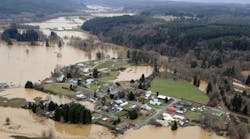Hurricane Michael Downgraded to a Tropical Storm
Hurricane Michael has been downgraded to a tropical storm and continues to move northeast over the Carolinas. The powerful storm continues to cause flash flooding, storm surges and power outages as it moves towards the Atlantic Ocean. Additionally, tornadoes are impacting areas hit by the storm.
Michael touched down Wednesday, Oct. 10, at approximately 12:30 p.m. in Mexico Beach, Fla., with 155 mph winds as a Category 4 hurricane, making it the strongest hurricane recorded to make landfall in Florida and the strongest hurricane to hit the U.S., this year. Already, two deaths have been attributed to the storm, a man in Florida and a young girl in Georgia, due to flying debris, as reported by CNN.
"Hopefully they don't, but those numbers could climb as search and rescue teams get out," said Brock Long, head of the Federal Emergency Management Agency.
Mexico Beach and Panama City, Fla., were hit the hardest, with roofs blown off of homes, uprooted trees and heavy flooding. According to CBS News, more than 664,000 customers are without power following the devastating storm throughout Alabama, Georgia, Florida and South Carolina. Nearly 30 million people in the Southeast have felt the effects of the storm.
Throughout Thursday, Oct. 11, Tropical Storm Michael is expected to rain 4 to 7 in. from eastern Georgia to the southern mid-Atlantic, with up to 9 in. of rain in parts of the Carolinas still recovering from Hurricane Florence.
"Now our job is to search for everybody, rescue everybody, get everybody the resources they need and we'll recover. We are a very resilient state," said Florida Gov. Rick Scott.
As the storm moves northeast, emergency responders throughout Georgia, Alabama and the Florida Panhandle are working to clear roadways and provide aid to those hit hardest by the storm.


